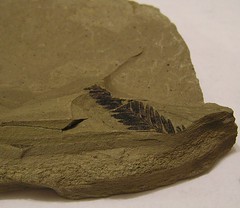
During the middle Eocene, 45-50 m.y.a., a number of freshwater lakes appeared in an arc extending from Smithers, through the modern Cariboo, to Kamloops, the Nicola Valley, Princeton, and Republic, WA. The lakes likely formed after a period of faulting produced a number of basins, called grabens into which water collected.
The faulting was followed by a time of volcanism that produced periodic falls of fine-grained ash. The ash washed into the lakes and because of its texture, and possibly because of low water oxygen levels on the bottoms that slowed decay, plant, invertebrate, and fish fossils were preserved in wonderful detail.
Princeton boasts many fossil exposures within the middle Eocene, Allenby Formation and most enjoying a high degree of preservation. A crack of the hammer yields fossil maple, alder, fir, pine, dawn redwood and ginko fossil material. Several species of fossilized insects can be found in the area and rare, but occasional fossil flowers and fish. Being in the southeastern corner of British Columbia, the fossil beds are covered by a layer of snow well into April.
The perfect time to head east and collect would be the months of May and June, as July brings the tourists and the mighty RV's that infect their small highways. I'll be heading out to see what wonderous new finds can be unearthed as winter turns to spring.






Comments